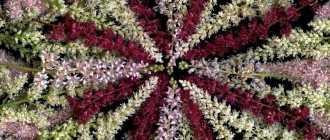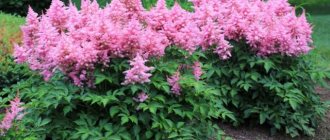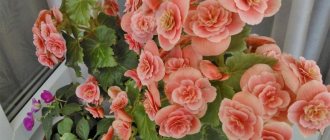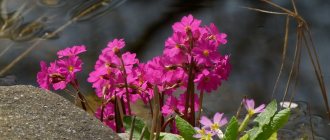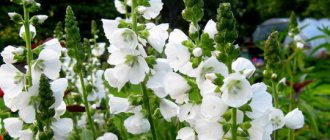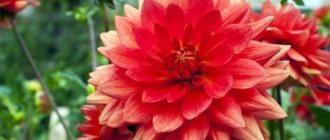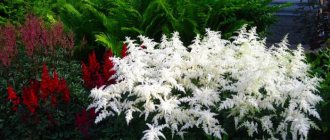5/5 — (3 votes)
Astilbe, due to its unpretentiousness, is often called a plant for beginners. It does not lose its decorative value when grown in one place for up to 10 years, and is resistant to cold, diseases and pests. But most importantly, she is charming!
Astilbe is a herbaceous perennial from the Saxifraga family, its homeland is China and Japan. Several varieties are grown in gardens. From a large number of different varieties, you can select plants that bloom almost from the beginning of summer until November. The earliest of all is Japanese astilbe. It grows in low bushes 60-70 cm high with lacy glossy leaves with reddish or brown veins. Paniculate inflorescences are formed by small, pink flowers with a faint aroma, vaguely similar to hydrangea.
The color of astilbe inflorescences is varied - from white, cream, pink, bluish to red and purple. Plant varieties, in addition to the color of the inflorescences, differ in their shape and density, as well as the color of the leaves and ripening time. Looks very good in group plantings near bushes, in the shade of tall trees or walls. Astilbe panicles are used for cutting and dry bouquets.
What types of astilbes are there?
Photos and names of astilbe varieties show that the culture is represented by many variations. Plants differ from each other in size and shade of flowering, when buds appear and in growing requirements.
Chinese (Astilbe chinensis)
The perennial grows up to about half a meter above the ground. Brings lush paniculate clusters, most often with pink buds. It develops most readily in shaded and damp areas.
Chinese astilbe blooms in late summer
Korean (Astilbe koreana)
A plant with light green foliage and slightly fluffy stems blooms in drooping inflorescences. It reaches its peak of decorativeness in July; the panicles of the species are white-yellow or pinkish, very beautiful.
Flowering of Korean astilbe lasts up to three weeks
Arends (Astilbe arendsii)
Plants of this species stretch up to 1 m. They have spreading stems and rich green leaves. Inflorescences of apical type, lush, of all possible shades. The species is popular in breeding and is a predecessor for many varieties.
Astilbe Arends, depending on the variety, blooms from the beginning to the end of summer
David's (Astilbe davidii)
The tall species, up to 1.5 m above the ground, is distinguished by its spreading nature. The rugged leaves are light green, the flowers are pink with a purple tint, collected in lush and long brushes. The species blooms in the second half of summer and remains decorative for about two weeks.
Attention! Many hybrids have been bred based on Astilbe David.
The pyramidal inflorescences of Astilbe David can reach 40 cm in length
Thunberg (Astilbe thunbergii)
A medium-sized perennial up to 80 cm above the ground, it has straight, strong stems and feathery green leaves. It blooms with pink, white and lilac panicles and enters the phase of maximum decorativeness at the end of July.
Astilbe Thunberg inflorescences reach 25 cm long
Naked (Astilbe glaberrima)
The low perennial reaches only 12 cm above the ground; during the decorative period, due to the peduncles, it rises to 30 cm. The panicles of the species are usually pale pink and loose. Flowering occurs in July and August.
Naked astilbe grows well in moist soils in the shade
Simple leaf (Astilbe simplicifolia)
A rather rare species of perennial reaches 50 cm above the ground. It blooms with pyramidal or drooping panicles. The buds can be red, pink or white.
Simple-leaved astilbe usually blooms in August
Japanese (Astilbe japonica)
A low perennial with dark green glossy leaves and lush paniculate inflorescences. The shade is determined by the variety - the buds can be pink, white or deep red. The species rises on average up to 60 cm above the ground.
Japanese astilbe blooms closer to the first days of August
Varieties of red and burgundy astilbe
Red astilbe provides a good contrast in any flower bed. It gives the flower garden richness and expressiveness and combines with dark and light neighboring plants.
Rubin
The variety grows up to 80 cm above the ground. It has glossy bright green leaves; the shoots of the bushes are light pink in spring, but gradually darken. The inflorescences are usually red-violet, closer to burgundy, and appear on the stems in mid-July.
Ruby remains decorative for 20 days
Montgomery
Beautiful astilbe with dark green trifoliate leaves blooms in dense crimson-red inflorescences. It produces panicles in mid-summer and remains attractive for two weeks. It becomes a decoration of shady areas of the garden; it develops poorly in sunny and dry places.
The Montgomery variety grows up to 70 cm
Reproduction
Astilbe is propagated by seeds or vegetatively - by dividing the bush or by renewal buds.
Seeds
When using the seed method, it is better to use ready-made planting material from the store. Seeds collected from your own plants do not always ripen, have low germination rates and do not fully convey varietal characteristics.
Astilbe seeds are very small, take a long time to germinate and require preliminary stratification - prolonged exposure to low temperatures. Taking into account this treatment, sowing begins earlier - in January - February.
The boxes are filled with a moist substrate consisting of peat and sand. Peat is taken 3 times more than sand. The seeds are laid out superficially, without planting deeply. Cover the containers with a plastic bag and put them in the refrigerator for 14–20 days.
Then the crops are transferred to a warm place with an air temperature of 18–20°C. Ventilate daily, and when the soil surface dries out, moisten it with a spray bottle. The thin seedlings that appear are carefully watered with a syringe, but now around the sprouts.
If the seedlings are thickened, then they are picked after the growth of 2-3 true leaves. Seedlings are planted in open ground at the end of May - beginning of June, when there is no longer any fear of return frosts. Flowering of seedlings occurs in the 3rd year.
Dividing the bush
Most often, astilbe is propagated by dividing bushes . They are divided in spring or summer, but no later than the first half of August - the plant needs time to take root in a new place.
The above-ground part is cut off, the plant is dug up and taken apart. For very overgrown plants, you will need a sharp knife. For planting, young and strong parts are selected from the edges of the bushes; the middle are old rhizomes; it is better to throw them away. The delenki are immediately planted in a permanent place. They are watered and mulched to prevent moisture evaporation.
Kidney renewal
Propagation by renewal buds is also considered an effective method. In early spring, they are cut off along with pieces of rhizome and placed for rooting in a mixture of peat and sand in a 3:1 ratio. The rooting process lasts 2–3 weeks.
Varieties of pink astilbe
During the decorative period, pink astilbe looks airy and very delicate. It is recommended to combine it with white or cream flowering perennials.
Gloria Purpurea
This unusual variety attracts attention in spring, first of all, with its dark red leaves. They acquire their traditional green color only in the summer as the bush matures. The panicles are small, up to 20 cm, dark pink. They bloom at the end of July, and by mid-August they are already withering. The flowers do not emit any characteristic aroma.
Gloria Purpurea grows up to 70 cm above the ground
Sister Theresa
A hybrid species of astilbe up to 50 cm tall produces large and lush rhombic panicles. The color of the buds is creamy pink, beautiful and delicate.
Attention! The leaves of the Sister Teresa variety are dark green at first, but become lighter as the bush matures.
Astilbe Sister Teresa emits a pleasant light aroma
The best varieties of astilbe with white flowers
Perennials with white blooms are very popular. Such species look spectacular in the shade and help give the site mystery and romance.
Weiss Gloria
The perennial blooms in early July with beautiful creamy white panicles that emit a pleasant light aroma. The bushes hold their shape well and look attractive in group and single plantings. The inflorescences of the species are dense and massive.
The decorative period of the Weiss Gloria variety lasts for two weeks
Diamond
A tall variety up to 90 cm is distinguished by its grace; it blooms with snow-white panicles, loose and weightless. Looks good next to other perennials or conifers. It is better not to plant the crop in brightly lit areas, but in the shade it develops quickly and without difficulty.
White astilbe Diamant is well suited for cutting
Briefly about agricultural technology
Caring for hybrid astilbe is no different from other types and forms. Decorative garden crops also love diffused shade, loamy soil and lots and lots of moisture. The herbaceous perennial is not afraid of cold weather; the bushes do not need shelter. Much more often astilbe dies due to heat and drought than from freezing.
The plant is propagated by dividing the branched rhizome (every 3-5 years). Self-sowing or germinating seeds into seedlings is not practiced. There is no need to wait for shoots.
Fertilizing hybrid astilbe three times a year will significantly improve the appearance of the bushes. In the spring, a solution of nitrogen compounds is added to the holes, in the summer - phosphorus-potassium mixtures, in the fall - compost mixed with peat. However, this item is optional. Even without fertilizers, the plant will bloom profusely and on time.
The most beautiful dwarf, low-growing varieties of astilbe
Most species reach a height of 0.6-1 m. But there are also low-growing plants that can be planted in borders and miniature compositions.
White Sensation
A miniature variety of astilbe, about 25 cm tall, bears feathery snow-white panicles of drooping type. The decorative appearance of the species is complemented by dark green small leaves. The perennial is often planted in group miniature compositions and used to decorate paths.
Attention! White Sensation has good frost resistance down to -30 °C.
White Sensation blooms from July to August
Pumila
A low perennial up to 30 cm with light green leaves produces straight, thin stems. The inflorescences of the species are paniculate, directed upward, and have a lilac-pink hue. Blooms in mid-summer, prefers shady areas of the garden.
Pumila is a good honey plant
The highest varieties of astilbe
Tall astilbe with stems of 80 cm or more is widely used in landscape design. These species are planted in flowerbeds and mixborders, and fences and building facades are decorated with perennials.
Amethyst
An 80-100 cm tall variety with matte light green leaves blooms in mid-July and remains decorative until the end of the month. The inflorescences are lilac-pink, large, up to 30 cm in length. The perennial has good cold resistance and general unpretentiousness.
Astilbe Amethyst can be grown in sunny areas
Cattleya
The Cattleya hybrid grows up to 70-90 cm. Photos of the tall astilbe variety show that the inflorescences of the species are diamond-shaped, bright, pink. The beauty of the panicles is well emphasized by jagged green leaves, on the edges of which you can see a brown border in spring.
The Cattleya variety is recommended to be planted in partial shade on well-moistened soil.
Landing rules
The development of a plant depends on the place where it grows. It is necessary to select comfortable conditions for everyone. This is the key to the success of beautiful and healthy astilbe bushes.
Selecting a location
Astilbe loves warmth, but it is better for it to grow in partial shade, in rarefied light . Bushes growing in sunny areas bloom less. The color of the inflorescences becomes much paler.
Flowerbed with astilbes
There are sun-loving varieties, but they are few. They differ in early or late flowering. The same species that bloom in mid-summer are recommended to be planted in the shade.
The soil
The plant can grow on any soil. If possible, you need to choose places with groundwater close to the surface.
Astilbes near a pond
Preparing the soil for planting:
- Before planting, the selected location must be dug up.
- Remove roots of other plants from the ground.
- Add humus or peat. 2 buckets are poured per square meter.
- The top layer of soil should contain potassium and phosphorus. To do this, add inert meal or complex mineral fertilizer. 30 - 50 grams per square meter is enough.
Astilbe is not recommended to be planted near trees with shallow roots. They will fight for incoming moisture. The fight will end unfavorably for the flower.
Landing
It is best to plant astilbe in the fall.
The air temperature should be kept from 5 degrees Celsius and above. The distance between bushes should be 30 cm for dwarf and low varieties, and 50 cm for medium and tall ones.
Step-by-step instruction:
- Dig a hole to a depth of 30 cm.
- Add fertilizer and water.
- Plant an astilbe bush.
- Cover the top with mulch. The layer must be at least 3 cm.
In the first year after planting, astilbe gains color. Experienced flower growers recommend cutting off the buds. A fragile plant will give all its strength to the inflorescences and may die.
The best varieties of astilbe for the Moscow region
Descriptions and photos of astilbe species and varieties show that almost any perennials are suitable for the Moscow region, except for the most heat-loving ones. Winters in the region are usually moderate, with temperatures averaging -25°C.
Brunhilde
A tall variety up to 80 cm above ground level blooms at standard times in July and early August. The panicles are large, up to 40 cm long, and very lush, light pink in color.
The Brunhilde variety tolerates cold temperatures down to -30 °C
Deutschland
One of the best varieties of astilbe with dense inflorescences produces shoots up to 60 cm tall with lush snow-white panicles. It does not require complex care; it mainly needs regular watering and simple fertilizing. It can grow successfully in lightly shaded areas.
Attention! Astilbe Deutschland is compact and suitable for dense planting.
In the shade, Deutschland astilbe blooms longer than in the sun.
How to plant and care for astilbe in open ground in Siberia and the Urals
Friends, I often see the question of how to grow astilbe in open ground in Siberia or the Urals. I would like to note that the Urals are divided into 5 parts, from the southern to the polar, and Siberia extends from the borders with Mongolia to the Arctic Ocean. To say how you can grow a plant in such an area is to say nothing. Yes, whatever, the Urals or Siberia, in the city where I live, in winter the temperature in different parts differs by 10 degrees or more.
It is always necessary to focus on your climatic conditions in your region. Sometimes one site is located on the northern slope of the mountain, where cold winds often blow, and the other on the southern slope, where there are no winds. These areas will have different conditions for caring for plants.
Therefore, just follow the rules for caring for astilbe, which I described above and act based on the local conditions of keeping your pets. And everything will work out!
That's all for me. I hope you have found information on caring for a very beautiful plant, and it will delight you with its beauty. Until next time.
Sincerely, Alexander.
The best astilbe varieties for Siberia
In Siberia, astilbe has to winter at extremely low temperatures. For cultivation in this region, it is necessary to select unpretentious species with high frost resistance.
Heart and Soul
A beautiful medium-sized species up to 55 cm blooms with lush panicles in the second half of summer. It has modest requirements for conditions and rapid growth. The inflorescences are bright pink, dense and showy.
Hart & Soul endures temperatures as low as -35°C
Spartan
This burgundy-red, unpretentious variety rises up to 80 cm above the flowerbed. It is often used for planting in the center of artistic compositions due to the rich, rich shade of the panicles. It is characterized by high frost resistance, suitable for breeding not only in Siberia, but also in Scandinavia.
Spartan begins to bloom in August
How to combine with other plants
The best flowerbed partners for her are shade-loving perennial flowers with smooth leaves, which will provide a good contrast with the leaves of astilbe. In the club and in the photo, astilbe goes well with hellebore, podophyllum, and bergenia.
The beauty of this perennial is emphasized by the bright colors of late varieties of tulips, the blue of irises, the tenderness of the first spring lilies of the valley and the small flowers of mountain weed.
New varieties of astilbe
Astilbe is very popular in landscape design, so new plant varieties appear every now and then. Many of them receive awards at international exhibitions and immediately attract the attention of gardeners.
Mighty Chocolate Cherry
A tall variety up to 1.2 m looks equally attractive both during and after flowering. The panicles are bright cherry, large and lush, directed upward. The cut leaf blades have a chocolate tint, so the bushes look decorative throughout the season.
Mighty Chocolate Cherry blooms in August
Cappuccino
The variety with cream inflorescences and brownish-green leaves is suitable for planting in moist areas with good shade. The height of the perennial is about 50 cm, the panicles of the species are dense, directed upward.
The Cappuccino variety begins flowering at the end of July
Caring for astilbe in the fall and preparing for winter
As I already wrote, astilbe is an unpretentious plant with good frost resistance, and you may get the impression that you can do nothing in the fall. The opinion is not entirely correct; some actions still need to be taken. This especially applies to first-year plants.
In order for a young bush to winter well, you should not let it bloom in the first year of its life. Peduncles should be removed immediately, even before inflorescences form. In this case, nutrients will go more towards the development of the root system.
The plant needs pruning. Pruning is usually carried out in two stages. The first time is pruned when the plant has finished flowering. This is done to prevent seed pods from being planted, otherwise they will take away some of the nutrients from the bush. If you prune them, the plant will come into winter stronger and stronger. At the same time, for the rest of the time, the lush green bush will continue to delight you with its beauty until autumn.
The second time pruning is carried out after the onset of frost. The entire upper part of the plant is cut back to the ground. Don’t be afraid to cut off excess, the top part dies off in the fall and the plant begins to grow from the root buds every year.
In the autumn, fertilizer should be applied to each bush. The main elements needed by the plant after flowering are potassium and phosphorus. If you use dry vermicompost, add 0.5 kg to each bush. If using mineral fertilizers, add 1-2 tbsp. complex fertilizer (approximately 30g per 1 sq.m.), previously dissolved in 10 liters of water.
As I already wrote, the root system of astilbe grows upward over time and begins to climb out of the ground. Therefore, plants older than 5 years are subject to mandatory mulching of the tree trunk circle, and it is also advisable to cover the trimmed plant with non-woven material (lutrasil, spunbond) or coniferous spruce branches to protect the roots from freezing.
Thus, the list of work performed in the fall comes down to the following operations:
- pruning
- feeding
- mulching and shelter for the winter
Autumn pruning of the plant
Friends, I want to share with you a video that tells and shows how to prune astilbe in the fall, as well as what else needs to be done so that the plant overwinters well.
Early varieties of astilbe
Astilbe generally blooms in late July and August. But some varieties bloom in the first half of summer.
Purple Rain
The medium-sized species reaches 50 cm and blooms in the second half of June. The inflorescences are compact - only 10-12 cm in length. But the beautiful purple-violet hue of the panicles allows the variety to stand out very clearly against the background of other plants in the garden.
Blooming Pearl Rain can last more than three weeks
Crispa Perkeo
The dwarf variety grows only up to 20 cm. It begins to bloom in late June and bears compact but lush light pink panicles. The plant is additionally decorated with openwork leaves.
Attention! It is recommended to plant a miniature species of Crispa Perkeo on alpine hills.
Crispa Perkeo grows well in partial shade
Late varieties of astilbe
Late astilbe blooms at the very end of summer or early autumn. Varieties that remain decorative for a long time are in demand - they decorate the garden right up to the cold weather.
Hennie Graafland
Astilbe with shoots up to 70 cm above the ground bears long thin inflorescences of a pale pink hue. Blooms in late August; in good weather it can remain decorative for up to 40 days.
Panicles of the Henny Grafland species can reach 40 cm in length
Inshriach Pink
A low species up to 40 cm above the ground produces light pink inflorescences, slightly drooping towards the ground. Blooms in August, remains attractive until mid-September. In addition to flowers, dark green leaves with a bronze tint attract attention.
The compact variety Inshriah Pink is suitable for growing both in the ground and in a pot.
Varieties of astilbe simplefolia
The leaf blades of simple-leaved varieties look modest and are not particularly decorative. But eye-catching inflorescences of drooping type attract attention.
Bronce Elegans
A beautiful variety up to 30 cm tall blooms with panicles of an unusual salmon-pink hue. The leaves also deserve attention. Simple in shape, they have a bronzed tint when young and then turn dark green.
Bronze Elegance begins flowering at the end of July
Precox Alba
A low-growing species up to 40 cm blooms with snow-white conical panicles. The inflorescences are slightly drooping; during the decorative period, the variety looks as if it was dusted with snow.
Precox Alba begins flowering in July
Diseases and pests
In the middle zone there is a relatively small variety of insects that can harm crops (3 in total). The remaining pest populations are common in the homeland of astilbe. In order to prevent the appearance of unwanted guests, they get rid of weeds in a timely manner and do not plant densely. If it was not possible to avoid pests, then immediate measures are taken to remove them.
The spittlebug lays larvae in the leaf axils, and soon foamy lumps appear there. This causes the leaves to wrinkle and become spotted, and then the bush itself withers. Both traditional and chemical methods are used to combat pennies.
The lumps are sprinkled with wood ash, thus destroying the larvae inside, or they resort to such means as karofos or actara.
The strawberry nematode causes damage to almost all parts of the plant - buds, leaves and flowers. Subsequently, they undergo deformation and acquire unwanted brown spotting, while the development of the bush significantly slows down.
A sign of the presence of a root-knot nemotode is considered to be growths on the surface of the roots; it is inside these formations that the pest lives, even though it is small in size. During the second period of the growing season, the nematode becomes easily noticeable. They first slow down the development of the bush, and after a while even lead to its death. As a preventive measure, they try to inspect the plant more often; if there are symptoms of the disease, the perennial is destroyed. Carry out timely weeding, especially in the first growing season. Treated with Fitoverm.
Astilbe varieties for sunny places
Astilbe is a shade-loving crop and usually prefers damp areas with little light. But some varieties can grow in full sun.
Weise Perle
A perennial up to 70 cm tall, it is a rare species. Brings large and loose panicles of white and pink color. Each brush can reach 30 cm in length.
Astilbe Weiss Pearl blooms in mid-July
Bergkristall
The hybrid is particularly lush. It reaches a height of about 120 cm. It blooms very profusely, producing yellowish-white panicles, spectacular in the sun.
In hot weather, it is recommended to slightly cover Bergcrystal astilbe from direct rays
